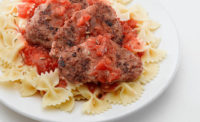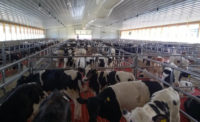Veal stays strong despite continue industry challenges


By Dale Bakke
American Veal Association, President
To say the past 12 to 18 months have been a challenge is an understatement. The food industry continues to determine the new normal during a never-ending pandemic as shortages of labor, supplies, and transportation plague the trade. But the veal industry is resilient and remains solid during these most challenging times.
Continued Tight Market
Challenges faced by the veal industry have been widespread and not isolated to just one faction. Producers have cut back on production, as demand from foodservice has dropped and calf prices have increased. Summer calf harvest was down about 30 percent year-on-year driven by reduced foodservice usage that has been met through freezer inventories from 2020. Increased demand in Asia for whey proteins along with a growing popularity among the health-conscious worldwide has been driving price increases for whey products, which impacts the cost of the feed formula for veal calves.
The chart below illustrates the average feed cost based on a fixed formula over the past seven years using data from USDA’s Agricultural Marketing Services (AMS) Dairy Market News (DMS), based on whey and whey protein concentrate weekly prices. The cost of the veal formula feed prices has been challenged by large increases in dairy ingredient prices and a near doubling in the cost of fat that is not reflected in the chart below. The 2021 prices are through week 37 of the year.
As the pandemic continues, so do challenges with labor, whether you’re a producer, food processor or feed plant operator. Current employees are asked to work overtime to cover short-staffed shifts while employers are struggling to implement protocols around vaccine mandates. This of course interrupts productivity and adds cost to the bottom line.
People are Discovering Veal at Home
Consumers are returning to restaurants, albeit at a slow pace. Meanwhile, they are continuing to cook at home and taking on more complicated dishes than they did in 2020. This has been a great opportunity for veal, as consumers are focusing on quality over quantity when compared to 2020, according to the 2021 Power of Meat study. This in turn is driving demand of specialty proteins like veal at retail outlets. While retail SKU counts have decreased in the three major proteins of chicken, pork and beef, we’ve seen veal and other exotic protein SKU counts increase by 88 percent, per the 2021 National Meat Case Study.

Additionally, veal is being offered as an alternative to the big three proteins for special events whether it is at retail or food service establishments, as evidenced by consumer surveys. The younger generations have increased their purchases of meat protein during COVID and are experimenting with alternative meat proteins like veal.
Helping to Influence Consumers
To help continue the trend of learning more about veal, American Veal Association (AVA) members hosted a social influencer tour in April. The tour was funded by the Beef Checkoff to help consumers and other farmers learn more about the veal industry. Three online influencers participated in the in-person tour and have since then posted information about their experience online.
“I wasn’t sure how much of what I had heard about veal production was fact and how much was fiction,” said Carrie Mess of Dairy Carrie (view article). “So, I was thankful to be invited along on this tour so that I could see with my own eyes how veal calves are raised and yes, slaughtered. This tour was a full experience. They hid absolutely nothing from our group, and we had full access to see everything.”
The online social media content has directly reached more than 68,000 people, and nearly 700 people have engaged in the content with comments and shares. One example includes an agriculture teacher in Florida who wrote, “… I had very limited knowledge about veal – although the question comes up every year from a student. Thank you so much for teaching me!”
The reaction from these bloggers is not unlike what others have said about how veal is raised today. Once they visit farms and see for themselves, they are eager to share the information. As Carrie said, “I can tell you for sure that after touring veal farms, a veal processing plant and even a feed mill that makes feed for veal calves my eyes have been opened.”
Continued Pressure from Potential State Mandates
The American Veal Association understands and appreciates consumer interest in how their food is produced. The health and well-being of veal calves is foundational to how we farm. We welcome that interest and are committed to transparency. Scrutiny of the veal industry continues as states look to California’s Proposition 12 (also known as Prop 12) that was implemented in January 2021. However, we ask that states considering similar requirements talk with someone from the AVA board and consider the following:
- Food safety and animal well-being are not just words on paper in our Statement of Principles. These values are represented in our practices each day as we care for and raise veal calves.
- The care and handling, nutrition, and housing are all done to ensure calves remain healthy, grow and thrive. That has been, and will continue to be, a priority for AVA members.
- In developing proposed rules to implement California Proposition 12, the California Department of Food & Agriculture (CDFA) said in its Initial Statement of Reasons, “Minimum space requirements for veal calves and breeding sows outlined in Health and Safety Code (HSC) are not drawn from specific industry standards or published scientific research prescribing 43 square feet for veal calves and 24 square feet for breeding pigs.” (CDFA Initial Statement of Reasons p. 146-147.)
- CDFA also said, “Animal confinement space allowances prescribed in the Act (cage-free for egg-laying hens, 43 square feet for veal calves and 24 square feet for breeding pigs) are not based in specific peer-reviewed published scientific literature or accepted as standards within the scientific community to reduce human foodborne illness, promote worker safety, the environment, or other human or safety concerns.”
Weathering the Storm
The veal industry continues to meet the obstacles thrown our way head-on by continuing to be as efficient as possible and working together as a team. Like any business, when costs increase, we have been working to lower other areas of expense. Increased efficiency on truck routes or procedures in the plant help gain valuable time needed to make it through a challenging time.
Looking for a reprint of this article?
From high-res PDFs to custom plaques, order your copy today!






